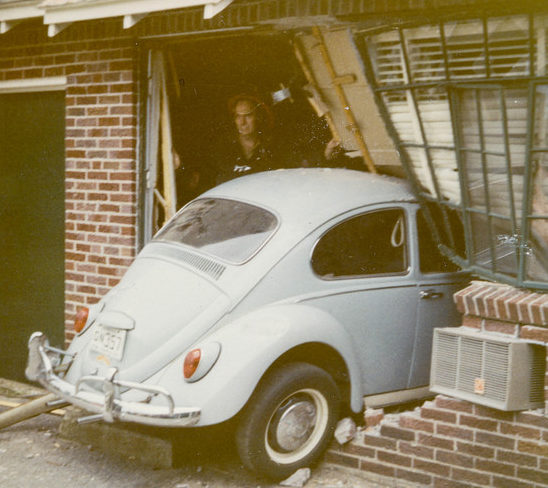Is your work meaningful?
 Life’s too short to work on things that don’t make a difference. Sure, you’ve got to earn a living, but what kind of living is it if all you’re doing is paying for food and a mortgage? How do others benefit from your work? How does the planet benefit from your work? How is the world a better place because of your work? How are you a better person because of your work?
Life’s too short to work on things that don’t make a difference. Sure, you’ve got to earn a living, but what kind of living is it if all you’re doing is paying for food and a mortgage? How do others benefit from your work? How does the planet benefit from your work? How is the world a better place because of your work? How are you a better person because of your work?
When you’re done with your career, what will you say about it? Did you work at a job because you were afraid to leave? Did you stay because of loss aversion? Did you block yourself from another opportunity because of a lack of confidence? Or, did you stay in the right place for the right reasons?
If there’s no discomfort, there’s no growth, even if you’re super good at what you do. Discomfort is the tell-tale sign the work is new. And without newness, you’re simply turning the crank. It may be a profitable crank, but it’s the same old crank, none the less. If you’ve turned the crank for the last five years, what excitement can come from turning it a sixth? Even if you’re earning a great living, is it really all that great?
Maybe work isn’t supposed to be a source of meaning. I accept that. But, a life without meaning – that’s not for me. If not from work, do you have a source of meaning? Do you have something that makes you feel whole? Do you have something that causes you to pole vault out of bed? Sure, you provide for your family, but it’s also important to provide meaning for yourself. It’s not sustainable to provide for others at your own expense.
Your work may have meaning, but you may be moving too quickly to notice. Stop, take a breath and close your eyes. Visualize the people you work with. Do they make you smile? Do you remember doing something with them that brought you joy? How about doing something for them – any happiness there? How about when you visualize your customers? Do you they appreciate what you do for them? Do you appreciate their appreciation? Even if there’s no meaning in the work, there can be great meaning from doing it with people that matter.
Running away from a job won’t solve anything; but wandering toward something meaningful can make a big difference. Before you make a change, look for meaning in what you have. Challenge yourself every day to say something positive to someone you care about and do something nice for someone you don’t know all that well. Try it for a month, or even a week.
Who knows, you may find meaning that was hiding just under the surface. Or, you may even create something special for yourself and the special people around you.
Image credit – Greg
Your response is your responsibility.
 If you don’t want to go to work in the morning, there’s a reason. If’ you/re angry with how things go, there’s a reason. And if you you’re sad because of the way that people treat you, there’s a reason. But the reason has nothing to do with your work, how things are going or how people treat you. The reason has everything to do with your ego.
If you don’t want to go to work in the morning, there’s a reason. If’ you/re angry with how things go, there’s a reason. And if you you’re sad because of the way that people treat you, there’s a reason. But the reason has nothing to do with your work, how things are going or how people treat you. The reason has everything to do with your ego.
And your ego has everything to do with what you think of yourself and the identity you attach to yourself. If you don’t want to go to work, it’s because you don’t like what your work says about you or your image of your self. If you are angry with how things go, it’s because how things go says something about you that you don’t like. And if you’re sad about how people treat you, it’s because you think they may be right and you don’t like what that says about you.
The work is not responsible for your dislike of it. How things go is not responsible for your anger. And people that treat you badly are not responsible for your sadness. Your dislike is your responsibility, your anger is your responsibility and your sadness is your responsibility. And that’s because your response is your responsibility.
Don’t blame the work. Instead, look inside to understand how the work cuts against the grain of who you think you are. Don’t blame the things for going as they go. Instead, look inside to understand why those things don’t fit with your self-image. Don’t blame the people for how they treat you. Instead, look inside to understand why you think they may be right.
It’s easy to look outside and assign blame for your response. It’s the work’s fault, it’s the things’ fault, and it’s the people’s fault. But when you take responsibility for your response, when you own it, work gets better, things go better and people treat you better. Put simply, you take away their power to control how you feel and things get better.
And if work doesn’t get better, things don’t go better and people don’t treat you better, not to worry. Their responses are their responsibility.
Image credit Mrs. Gemstone
Situational Awareness (Winter is Coming)
 Business and life are all about choosing how you want to allocate your time and money. In life, it’s your personal time and money and in business it’s the company’s.
Business and life are all about choosing how you want to allocate your time and money. In life, it’s your personal time and money and in business it’s the company’s.
If you’ve ever done any winter hiking, you know that it’s important to know the terrain. If there’s a mountain in the way, you either go over it or around it. But there is one thing you can’t do is pretend it’s not there. If you go around it, you’ve got to make sure you have enough energy, food, water and daylight to make the long trek to shelter. If you go over it, you’ve got to make sure you have the ice picks, crampons, down jackets and climbing skills to make it up and down to shelter. With winter hiking, the territory, gear and team capability matter. And the right decision is defined by situational awareness.
And what of the shelter? Does it sleep five, six or seven? And because you have seven on your team, it’s not really shelter if it sleeps five. And if you don’t know how many it sleeps, you’re not situationally aware. And if you’re not situationally aware, on five may fit in the shelter and two will freeze to death. Maybe before your trip you should look at the map and learn all the shelters their locations and how many the can hold. The right action and the safety of your crew depends on your situational awareness.
And the decision depends on how much daylight do you have left. Before you left basecamp it was possible to know when the sun will set. Did you take the time to look at the charts? Did you take advantage of the knowledge? If you don’t have enough sunlight, you’ve got to go over the top. If you do, you can take the leisurely great circle route around the mountain. And if you don’t know, you’ve got to roll the dice. I’d prefer to be aware of the situation and keep the dice in my pocket. And for that, you need to be aware of the situation.
Winter hiking is difficult enough even when you have maps of the terrain, weather forecasts, locations of the shelters and knowledge of when the sun will set. But it’s an unsafe activity when there are no maps of the territory, the weather is unknown and there’s no knowledge of the shelters. But that’s just how it is with innovation – the territory has never been hiked, no maps, no weather forecast, and shelters are unknown. With innovation, there’s no situational awareness unless you create it. And that’s why with innovation, the first step is to create the maps. No maps, no possibility of situational awareness.
The best people at situational awareness are the military. The know maps and they know how to use them. The know to do recon to position the enemy on the map and they know to use the situational awareness (the map, the enemy’s location, and their direction of travel) to decide how what to do. If the enemy’s force is small and in poorly defensible position, there are a certain set of actions that are viable. If the enemy force is large and has the high ground, it’s time to sit tight or retreat with dignity. (To be clear, I’m a pacifist and this military example does mean I condone violence of any kind. It’s just that the military is super good at situational awareness.)
If you’re not making maps of the competitive landscape, you’re doing it wrong. If you’re not moving resources around and speculating how the competition will respond based on the topography and your position within it, you’re not sharpening your situational awareness and you’re not taking full advantage of the information around you. If you don’t know where the mountains are you can’t avoid them or use them to slow your competition. And if you don’t know know where the shelters are an how many miles you can hike in a day, you don’t know if you’re overextending your position and putting your crew at risk.
Winter is coming. If you’re not creating maps to build situational awareness, what are you doing?
Image credit – Martin Fisch
Choosing What To Do
 In business you’ve got to do two things: choose what to do and choose how to do it well. I’m not sure which is more important, but I am sure there’s far more written on how to do things well and far less clarity around how to choose what to do.
In business you’ve got to do two things: choose what to do and choose how to do it well. I’m not sure which is more important, but I am sure there’s far more written on how to do things well and far less clarity around how to choose what to do.
Choosing what to do starts with understanding what’s being done now. For technology, it’s defining the state-of-the-art. For the business model, it’s how the leading companies are interacting with customers and which functions they are outsourcing and which they are doing themselves. In neither case does what’s being done define your new recipe, but in both cases it’s the first step to figuring how you’ll differentiate over the competition.
Every observation of the state-of-the-art technologies and latest business models is a snapshot in time. You know what’s happening at this instant, but you don’t know what things will look like in two years when you launch. And that’s not good enough. You’ve got to know the improvement trajectories; you’ve got to know if those trajectories will still hold true when you’ll launch your offering; and, if they’re out of gas, you’ve got to figure out the new improvement areas and their trajectories.
You’ve got to differentiate over the in-the-future competition who will constantly improve over the next two years, not the in-the-moment competition you see today.
For technology, first look at the competitions’ websites. For their latest product or service, figure out what they’re proud of, what they brag about, what line of goodness it offers. For example, is it faster, smaller, lighter, more powerful or less expensive? Then, look at the product it replaced and what it offered. If the old was faster than the one it replaced and the newest one was faster still, their next one will try to be faster. But if the old one was faster than the one it replaced and the newest one is proud of something else, it’s likely they’ll try to give the next one more of that same something else.
And the rate of improvement gives another clue. If the improvement is decreasing over time (old product to new product), it’s likely the next one will improve on a new line of goodness. If it’s still accelerating, expect more of what they did last time. Use the slope to estimate the magnitude of improvement two years from now. That’s what you’ve got to be better than.
And with business models, make a Wardley Map. On the map, place the elements of the business ecosystem (I hate that word) and connect the elements that interact with each other. And now the tricky part. Move to the right the mature elements (e.g., electrical power grid), move to the middle the immature elements (things that are clunky and you have to make yourself) and move to the middle the parts you can buy from others (products). There’s a north-south element to the maps, but that’s for another time.
The business model is defined by which elements the company does itself, which it buys from others and which new ones they create in their labs. So, make a model for each competitor. You’ll be able to see their business model visually.
Now, which elements to work on? Buy the ones you can buy (middle), improve the immature ones on the far left so they move toward the central region (product) and disrupt the lazy utilities (on the right) with some crazy technology development and create something new on the far left (get something running in the lab).
Choosing what to work on starts with Observation of what’s going on now. Then, that information is Oriented with analysis, synthesis and diverse perspective. Then, using the best frameworks you know, a Decision is made. And then, and only then, can you Act.
And there you have it. The makings of an OODA loop-based methodology for choosing what to do.
For a great podcast on John Boyd, the father of the OODA loop, try this one.
And for the deepest dive on OODA (don’t start with this one) see Osinga – Science, Strategy and War.
Validate the Business Model Before Building It.
 One of the best ways to learn is to make a prototype. Prototypes come in many shapes and sizes, but their defining element is the learning objective behind them. When you start with what you want to learn, the prototype is sure to satisfy the learning objective. But start with the prototype, and no one is quite sure what you’ll learn. When prototypes come before the learning objective, prototypes are inefficient and ineffective.
One of the best ways to learn is to make a prototype. Prototypes come in many shapes and sizes, but their defining element is the learning objective behind them. When you start with what you want to learn, the prototype is sure to satisfy the learning objective. But start with the prototype, and no one is quite sure what you’ll learn. When prototypes come before the learning objective, prototypes are inefficient and ineffective.
Before staffing a big project, prototypes can be used to determine viability of the project. And done right, viability prototypes can make for fast and effective learning. Usually, the team wants to build a functional prototype of the product or service, but that’s money poorly spent until the business model is validated. There’s nothing worse than building expensive prototypes and staffing a project, only to find the business model doesn’t hold water and no one buys the new thing you’re selling.
There’s no reason a business model can’t be validated with a simple prototype. (Think one-page sales tool.) And there’s no reason it can’t be done at the earliest stages. More strongly, the detailed work should be held hostage until the business model is validated. And when it’s validated, you can feel good about the pot of gold at the end of the rainbow. And if it’s invalidated, you saved a lot of time, money and embarrassment.
The best way to validate the business model is with a set of one-page documents that define for the customer what you will sell them, how you’ll sell it, how you’ll service it, how you’ll train them and how you’ll support them over the life of your offering. And, don’t forget to tell them how much it will cost.
The worst way to validate the business model is buy building it. All the learning happens after all the money has been spent.
For the business model prototypes there’s only one learning objective: We want to learn if the customer will buy what we’re selling. For the business model to be viable, the offering has to hang together within the context of installation, service, support, training and price. And the one-page prototype must call out specifics of each element. If you use generalities like “we provide good service” or “our training plans are the best”, you’re faking it.
Don’t let yourself off the hook. Use prototypes to determine the viability of the business model before spending the money to build it.
Image credit – Heather Katsoulis
Even entrepreneurial work must fit with the brand.
 To meet ever-increasing growth objectives, established companies want to be more entrepreneurial. And the thinking goes like this – launch new products and services to create new markets, do it quickly and do it on a shoestring. Do that Lean Startup thing. Build minimum viable prototypes (MVPs), show them to customers, incorporate their feedback, make new MVPs, show them again, and then thoselaunch.
To meet ever-increasing growth objectives, established companies want to be more entrepreneurial. And the thinking goes like this – launch new products and services to create new markets, do it quickly and do it on a shoestring. Do that Lean Startup thing. Build minimum viable prototypes (MVPs), show them to customers, incorporate their feedback, make new MVPs, show them again, and then thoselaunch.
For software products, that may work well, largely because it takes little time to create MVPs, customers can try the products without meeting face-to-face and updating the code doesn’t take all that long. But for products and services that require new hardware, actual hardware, it’s a different story. New hardware takes a long time to invent, a long time to convert into an MVP, a long time to show customers and a long time to incorporate feedback. Creating new hardware and launching quickly in an entrepreneurial way don’t belong in the same sentence, unless there’s no new hardware.
For hardware, don’t think smartphones, think autonomous cars. And how’s that going for Google and the other software companies? As it turns out, it seems that designing hardware and software are different. Yes, there’s a whole lot of software in there, but there’s also a whole lot of new sensor systems (hardware). And, what complicates things further is that it’s all packed into an integrated system of subsystems where the hardware and software must cooperate to make the good things happen. And, when the consequences of a failure are severe, it’s more important to work out the bugs.
And that’s the rub with entrepreneurship and an established brand. For quick adoption, there’s strong desire to leverage the established brand – GM, Ford, BMW – but the output of the entrepreneurial work (new product or service) has to fit with the brand. GM can’t launch something that’s half-baked with the promise to fix it later. Ford can come out with a new app that is clunky and communicates intermittently with their hardware (cars) because it will reflect poorly on all their products. In short, they’ll sell fewer cars. And BMW can’t come out with an entrepreneurial all-electric car that handles poorly and is slow off the start. If they do, they’ll sell fewer cars. If you’re an established company with an established brand, the output of your entrepreneurial work must fit with the established brand.
If you’re a software startup, launch it when it’s half-baked and fix it later, as long as no one will die when it flakes out. And because it’s software, iterate early and often. And, there’s no need to worry about what it will do to the brand, because you haven’t created it yet. But if you’re a hardware startup, be careful not to launch before it’s ready because you won’t be able to move quickly and you’ll be stuck with your entrepreneurial work for longer than you want. Maybe, even long enough to sink the brand before it ever learned to swim. Developing hardware is slow. And developing robust hardware-software systems is far slower.
If you’re an established company with an established brand, tread lightly with that Lean Startup thing, even when it’s just software. An entrepreneurial software product that works poorly can take down the brand, if, of course, your brand stands for robust, predictable, value and safety. And if the entrepreneurial product relies on new hardware, be doubly careful. If it goes belly-up, it will be slow to go away and will put a lot of pressure on that wonderful brand you took so long to build.
If you’re an established brand, it may be best to buy your entrepreneurial products and services from the startups that took the risk and made it happen. That way you can buy their successful track record and stand it on the shoulders of your hard-won brand.
Image credit – simpleinsomnia
The people part is the hardest part.
 The toughest part of all things is the people part.
The toughest part of all things is the people part.
Hold on to being right and all you’ll be is right. Transcend rightness and get ready for greatness.
Embrace hubris and there’s no room for truth. Embrace humbleness and everyone can get real.
Judge yourself and others will pile on. Praise others and they will align with you.
Expect your ideas to carry the day and they won’t. Put your ideas out there lightly and ask for feedback and your ideas will grow legs.
Fight to be right and all you’ll get is a bent nose and bloody knuckles. Empathize and the world is a different place.
Expect your plan to control things and the universe will have its way with you. See your plan as a loosely coupled set of assumptions and the universe will still have its way with you.
Argue and you’ll backslide. Appreciate and you’ll ratchet forward.
See the two bad bricks in the wall and life is hard. See the other nine hundred and ninety-eight and everything gets lighter.
Hold onto success and all you get is rope burns. Let go of what worked and the next big thing will find you.
Strive and get tired. Thrive and energize others.
The people part may be the toughest part, but it’s the part that really matters.
Image credit — Arian Zwegers
A Little Uninterrupted Work Goes a Long Way
 If your day doesn’t start with a list of things you want to get done, there’s little chance you’ll get them done. What if you spent thirty minutes to define what you want to get done and then spent an hour getting them done? In ninety minutes you’ll have made a significant dent in the most important work. It doesn’t sound like a big deal, but it’s bigger than big. Question: How often do you work for thirty minutes without interruptions?
If your day doesn’t start with a list of things you want to get done, there’s little chance you’ll get them done. What if you spent thirty minutes to define what you want to get done and then spent an hour getting them done? In ninety minutes you’ll have made a significant dent in the most important work. It doesn’t sound like a big deal, but it’s bigger than big. Question: How often do you work for thirty minutes without interruptions?
Switching costs are high, but we don’t behave that way. Once interrupted, what if it takes ten minutes to get back into the groove? What if it takes fifteen minutes? What if you’re interrupted every ten or fifteen minutes? Question: What if the minimum time block to do real thinking is thirty minutes of uninterrupted time?
Let’s assume for your average week you carve out sixty minutes of uninterrupted time each day to do meaningful work, then, doing as I propose – spending thirty minutes planning and sixty minutes doing something meaningful every day – increases your meaningful work by 50%. Not bad. And if for your average week you currently spend thirty contiguous minutes each day doing deep work, the proposed ninety-minute arrangement increases your meaningful work by 200%. A big deal. And if you only work for thirty minutes three out of five days, the ninety-minute arrangement increases your meaningful work by 400%. A night and day difference.
Question: How many times per week do you spend thirty minutes of uninterrupted time working on the most important things? How would things change if every day you spent thirty minutes planning and sixty minutes doing the most important work?
Great idea, but with today’s business culture there’s no way to block out ninety minutes of uninterrupted time. To that I say, before going to work, plan for thirty minutes at home. And set up a sixty-minute recurring meeting with yourself first thing every morning and do sixty minutes of uninterrupted work. And if you can’t sit at your desk without being interrupted, hold the sixty-minute meeting with yourself in a location where you won’t be interrupted. And, to make up for the thirty minutes you spent planning at home, leave thirty minutes early.
No way. Can’t do it. Won’t work.
It will work. Here’s why. Over the course of a month, you’ll have done at least 50% more real work than everyone else. And, because your work time is uninterrupted, the quality of your work will be better than everyone else’s. And, because you spend time planning, you will work on the most important things. More deep work, higher quality working conditions, and regular planning. You can’t beat that, even if it’s only sixty to ninety minutes per day.
The math works because in our normal working mode, we don’t spend much time working in an uninterrupted way. Do the math for yourself. Sum the number of minutes per week you spend working at least thirty minutes at time. And whatever the number, figure out a way to increase the minutes by 50%. A small number of minutes will make a big difference.
Image credit – NASA Goddard Space Flight Center
Testing the Business Model
 Sometimes we get caught up in the details when we should be working on the foundation. Here’s a rule: If the underlying foundation is not secure, don’t bother working on anything else.
Sometimes we get caught up in the details when we should be working on the foundation. Here’s a rule: If the underlying foundation is not secure, don’t bother working on anything else.
If you’re working on a couple new technologies, but the overall business model won’t be profitable, don’t work on the new technologies. Instead, figure out a business model that is profitable, then do what it takes (technology, simplification, process improvement) to make it happen. But, often, that’s not what we do.
Often, we put the cart before the horse. We create projects to make prototypes that demonstrate a new technology, but the whole business premise is built on quicksand. There’s a reason why foundations are made from concrete and not quicksand. It’s because you can build on top of a base made of concrete. It supports the load. It doesn’t crack, nor does it fall apart. Think Pyramid of Giza.
Because foundations are big and expensive they can be difficult and expensive to test. For example, if an innovation is based on a new foundation, say, a new business model, building a physical prototype of the new business model is too expensive and the testing will not happen. And what usually happens is the foundation goes untested, the higher level technology work is done, the commercialization work is completed and the business model fails because it wasn’t solid.
But you don’t have to build a full-scale prototype of the Pyramid of Giza to test if a pyramid will stand the test of time. You can build a small one and test it, or you can run an analysis of some sort to understand if the pyramid will support the weight. But what if you want to test a new business model, a business model that has never been done before, using new products and services that have never seen the light of day? What do you do? In this case, it doesn’t make sense to make even a scale model. But it does make sense to create a one page sales tool that describes the whole thing and it does make sense to show it to potential customers and ask them what they think about it.
The open question with all new things is – will customers like it enough to buy it. And, it’s no different with the business model. Instead of creating a new website, staffing up, creating new technologies and products, create a one-page sales tool that describes the new elements and show it to potential customers. Distill the value proposition into language people can understand, describe the novelty that fuels the value, capture it on one page, show it to customers, and listen.
And don’t build a single, one-page sales tool, build two or three versions. And then, ask customers what they think. Odds are, they’ll ask you questions you didn’t think they’d ask. Odds are, they’ll see it differently than you do. And, odds are, you’ll have to incorporate their feedback into an improved version of the business model. The bad new is you didn’t get it right. The good news is you didn’t have to staff up and build the whole business model, create the technologies and launch the products. And more good news – you can quickly modify the one-page sales tool and go back to the customers and ask them what they think. And you can do this quickly and inexpensively.
Don’t develop the technology until you know the underlying business model will be profitable. Don’t staff up until you know if the business model holds water. Don’t launch the new products until you verify customers will buy what you want to sell.
Creating a new business model from scratch is an expensive proposition. Don’t build it until you invest in validating it’s worth building.
The worst way to validate a business model is by building it.
Image credit – David Stanley
Make life easy for your customers.
 Companies that have products want to improve them year-on-year. This year’s must be better than last year’s. For selfish reasons, we like to improve cost, speed and quality. Cost reduction drops profit directly to the bottom line. Increased speed reduces overhead (less labor per unit) and increases floor space productivity (more through the factory). Improved quality reduces costs. And for our customers, we like to improve their productivity by helping them do more value-added work with fewer resources. More with less! But there’s a problem – every year it gets more difficult to improve on last year, especially with our narrowly-defined view of what customers value.
Companies that have products want to improve them year-on-year. This year’s must be better than last year’s. For selfish reasons, we like to improve cost, speed and quality. Cost reduction drops profit directly to the bottom line. Increased speed reduces overhead (less labor per unit) and increases floor space productivity (more through the factory). Improved quality reduces costs. And for our customers, we like to improve their productivity by helping them do more value-added work with fewer resources. More with less! But there’s a problem – every year it gets more difficult to improve on last year, especially with our narrowly-defined view of what customers value.
And some companies talk about creating the next generation business model, though no one’s quite sure of what the business model actually is and what makes for a better one.
To break out of our narrow view of “better” and to avoid endless arguments over business models, I suggest an approach based on a simple mantra – Make It Easy.
Make it easy for the customer to _____________.
And take a broad view of what customers actually do. Here are some ideas:
Make it easy to find you. If they can’t find you, they can’t buy from you.
Make it easy to understand what you do and why you do it. Give them a reason to buy.
Make it easy to choose the right solution. No one likes buying the wrong thing.
Make it easy to pay. If they need a loan, why not find one for them?
Make it easy to receive. Think undamaged, recyclable packaging, easy to get off the truck.
Make it easy to install. Don’t think user manuals, think self-installation.
Make it easy to verify it’s ready to go. No screens, no menus. One green light.
Make it easy to deliver the value-added benefit. We over-focus here and can benefit by thinking more broadly. Make it easy to set up, easy to verify the setup, easy to know how to use it, easy change over to the next job.
Make it easy to know the utilization. The product knows when it’s being used, why not give it the authority to automatically tell people how much free time it has?
Make it easy to maintain. When the fastest machine in the world is down for the count, it becomes tied for the slowest machine in the world. Make it easy to know what needs be replaced and when, make it easy to know how to replace it, make it easy to order the replacement parts, make it easy to verify the work was done correctly, make it easy to notify that the work was done correctly, and make it easy to reset the timers.
Make it easy to troubleshoot. Even the best maintenance programs don’t eliminate all the problems. Think auto-diagnosis. Then, like with maintenance, all the follow-on work should be easy.
Make it easy to improve. As the product is used, it learns. It recognizes who is using it, remembers how they like it to behave, then assumes the desired persona.
Though this list is not exhaustive, it provides some food for thought. Yes, most of the list is not traditionally considered value-added activities. But, customers DO value improvements in these areas because these are the jobs they must do. If your competition is focused narrowly on productivity, why not differentiate by making it easy in a more broader sense? When you do, they’ll buy more.
And don’t argue about your business model. Instead, choose important jobs to be done and make them easier for the customer. In that way, how you prioritize your work defines your business model. Think of the business model as a result.
And for a deeper dive on how to make it easy, here’s one of my favorite posts. The takeaway – Don’t push people toward an objective. Instead, eliminate what’s in the way.
Image credit – Hernán Piñera
The Slow No
 When there’s too much to do and too few to do it, the natural state of the system is fuller than full. And in today’s world we run all our systems this way, including our people systems.
When there’s too much to do and too few to do it, the natural state of the system is fuller than full. And in today’s world we run all our systems this way, including our people systems.
A funny thing happens when people’s plates are full – when a new task is added an existing one hits the floor. This isn’t negligence, it’s not the result of a bad attitude and it’s not about being a team player. This is an inherent property of full plates – they cannot support a new task without another sliding off. And drinking glasses have this same interesting property – when full, adding more water just gets the floor wet.
But for some reason we think people are different. We think we can add tasks without asking about free capacity and still expect the tasks to get done. What’s even more strange – when our people tell us they cannot get the work done because they already have too much, we don’t behave like we believe them. We say things like “Can you do more things in parallel?” and “Projects have natural slow phases, maybe you can do this new project during the slow times.” Let’s be clear with each other – we’re all overloaded, there are no slow times.
For a long time now, we’ve told people we don’t want to hear no. And now, they no longer tell us. They still know they can’t get the work done, but they know not to use the word “no.” And that’s why the Slow No was invented.
The Slow No is when we put a new project on the three year road map knowing full-well we’ll never get to it. It’s not a no right now, it’s a no three years from now. It’s elegant in its simplicity. We’ll put it on the list; we’ll put it in the queue; we’ll put it on the road map. The trick is to follow normal practices to avoid raising concerns or drawing attention. The key to the Slow No is to use our existing planning mechanisms in perfectly acceptable ways.
There’s a big downside to the Slow No – it helps us think we’ve got things under control when we don’t. We see a full hopper of ideas and think our future products will have sizzle. We see a full road map and think we’re going to have a huge competitive advantage over our competitors. In both situations, we feel good and in both situations, we shouldn’t. And that’s the problem. The Slow No helps us see things as we want them and blocks us from seeing them as they are.
The Slow No is bad for business, and we should do everything we can to get rid of it. But, it’s engrained behavior and will be with us for the near future. We need some tools to battle the dark art of the Slow No.
The Slow No gives too much value to projects that are on the list but inactive. We’ve got to elevate the importance of active, fully-staffed projects and devalue all inactive projects. Think – no partial credit. If a project is active and fully-staffed, it gets full credit. If it’s inactive (on a list, in the queue, or on the road map) it gets zero credit. None. As a project, it does not exist.
To see things as they are, make a list of the active, fully-staffed projects. Look at the list and feel what you feel, but these are the only projects that matter. And for the road map, don’t bother with it. Instead, think about how to finish the projects you have. And when you finish one, start a new one.
The most difficult element of the approach is the valuation of active but partially-staffed projects. To break the vice grip of the Slow No, think no partial credit. The project is either fully-staffed or it isn’t And if it’s not fully-staffed, give the project zero value. None. I know this sounds outlandish, but the partially-staffed project is the slippery slope that gives the Slow No its power.
For every fully-staffed project on your list, define the next project you’ll start once the current one is finished. Three active projects, three next projects. That’s it. If you feel the need to create a road map, go for it. Then, for each active project, use the road map to choose the next projects. Again, three active projects, three next projects. And, once the next projects are selected, there’s no need to look at the road map until the next projects are almost complete.
The only projects that truly matter are the ones you are working on.
Image credit – DaPuglet
 Mike Shipulski
Mike Shipulski